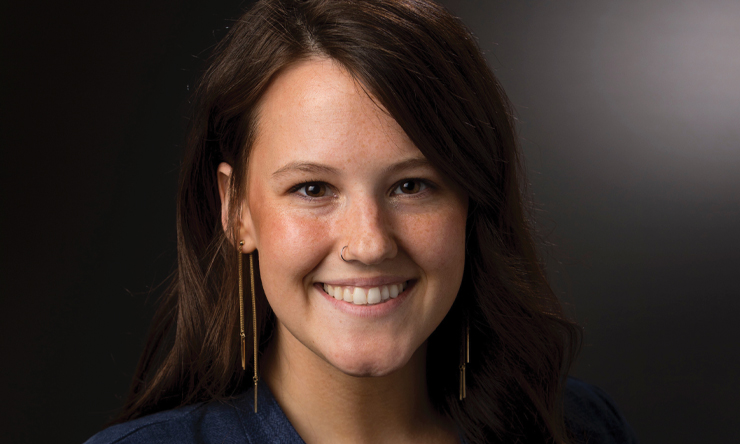by Ted Stephens III '01, '04
In his mind, it was like a scene out of a movie: A Roman Catholic priest from the Midwest moves swiftly through the Porta Sant' Anna, past the Gardes Suisses standing watch over the Santa Sede-The Holy See-and into the maze of passageways that make up the Il Vaticano.
He passes by Michelangelo's Cappella Sistina, Raphael's Stanze della Segnatura. There's a sense of urgency in his step. His heart is beating a mile a minute. If there were a soundtrack in the background, the beats would be low and ominous and on the verge of building into a lush crescendo.
But then, silence.
He's arrived at security. He checks in, handing over his passport (it is another country, after all).
And in the best Italian this Midwestern American can muster, he says, "Ho un appuntamento con Monsignore Cesare Pasini."
Into the Bibliotheca Apostolica Vaticana he goes: marble hallways where saints once walked have led him to a surprisingly stark, clinical, modern-looking elevator illuminated with fluorescent lighting. He presses the "up" button, steps in, takes a deep breath and thinks: "People don't get to do this everyday."
Intimidation has set in. The elevator rises. The bell dings. The doors split open.
Months earlier, Rev. Robert "Bud" Grant, PhD, had been scouring bookstore shelves in Milan when he came across "Ambrogio di Milano: Azione e Pensiero di un Vescova," a book he now recognizes as the best biography of Saint Ambrose available anywhere.
"I have to meet this guy," he had thought as he purchased Monsignor Cesare Pasini's book and scurried out the door in search of a street he had yet to walk down or a church door he had yet to walk through. Either was certain to reveal something new about ancient Milan or the man who had fascinated Fr. Grant since he was a freshman student on the college campus that bears the Ambrose name.
Now, Fr. Grant '80 sat across from Msgr. Pasini in his sprawling office adjacent to the larger-than-life reading room of the biblioteca, the solid, hardwood desks overpowered only by a ceiling full of Pinturicchio frescoes. He wasn't sure why Msgr. Pasini, the prefect of the biblioteca, agreed to meet with him, but he was glad that he had.
"I explained right away that I was a professor and priest at St. Ambrose University-the only university named after Saint Ambrose of Milan," he recalled. "This delighted the Monsignore to no end. He just started giving me books about Ambrose, and a list of people I needed to get to know."
Their conversation-all in Italian-turned scholarly, and on more than one occasion Msgr. Pasini flashed a curious smile, signaling that there was more to be discovered about Ambrose, the man the Monsignore had dedicated a lifetime to researching.
At one point during their discussion Fr. Grant asked whether Msgr. Pasini thought Ambrose had exercised any influence on Augustine, who framed the concepts of original sin. Msgr. Pasini leaned forward, conspiratorially tapped Fr. Grant on the arm and said, "Not so much his theology-more's the pity."
"I think he was implying things would have turned out very differently for the Church if Augustine would have listened to Ambrose," Fr. Grant said. "You see, this whole business of human nature being disastrously flawed, that we are only capable of sinning, Ambrose didn't believe that. He thought it was rubbish. Rather, he believed people should pick themselves up by their bootstraps and do what needs to be done. He believed Christians could do great things and sent people out to do them.
"If Augustine had inherited some of that confidence in human nature, we might not have this strain of pessimism that we have in Christianity today. This lack of confidence in our human being."
During this first meeting, Fr. Grant suggested that Msgr. Pasini's book needed to be translated to English. At that point, the only English-language book on Ambrose had been written by Neil McLynn. When Fr. Grant asked what Italian scholars thought of McLynn's book, which he described as essentially a character assassination on Ambrose, Msgr. Pasini smiled charitably. "You'll notice he hasn't written on the subject since," he replied.
With that, the two men bid farewell. As they did, Msgr. Pasini pulled an article he had written from his satchel-an introduction to Saint Ambrose of Milan, written in his native Italian. He gave it to Fr. Grant. "I had been given a test. He wanted me to translate it."
A Vision is Born
A year earlier on his farm near Stockton, Iowa, Fr. Grant awoke one morning and thought: "We are the only St. Ambrose University in the world. Saint Ambrose is the most neglected father of the Church. He is the least translated, the least represented in art, the least recognized. If you ask people who the fathers of the Church are, he is consistently eclipsed by Augustine.
"Why," Fr. Grant wondered of the university whose theology department he joined in 1994, "aren't we committing our work, our lives, to this man?"
That morning, he took the idea of a center, a physical home for the study and scholarship of Saint Ambrose of Milan, to Aron Aji, PhD, dean of St. Ambrose's College of Arts and Sciences.
"Why didn't we do this a hundred years ago?" Aji asked him.
The vision had been born: To build a true home. To form a place-the place-in the English-speaking world where students and scholars and religious men and women would gather to collaborate, share and learn about a man who became a bishop under the most extraordinary of circumstances.
Two years later, the vision is closer to reality.
"As we mold this center," Fr. Grant said, "St. Ambrose University will be the source of Ambrose scholarship in the liberal arts. It will be a focus for our identity as a diocesan university in the Catholic intellectual tradition. And it will be an investment in our commitment to being a leading Midwestern university, to defining what it truly means to be Ambrosian."
His da Vinci moment
At first, Fr. Grant wanted to name the center "The Ambrose Academy" in homage not only to the man, but also to the founding of the university in 1882. But a quick Google search to see if that name had been claimed yielded an unexpected result: a Classe Ambrosiana at the Biblioteca Ambrosiana in Milan. The classe was led by don Francesco Braschi.
"Naturally, I tracked him down. I had to," Fr. Grant quipped. "Braschi was a pleasant guy about my height, with a long beard that falls halfway down his body. He's quirky. And brilliant. We talked about projects we could collaborate on, and our unified mission of bringing the world to a greater understanding of who Ambrose was. And how relevant he can be to our life today."
As their first meeting came to a close, Braschi put on a pair of surgical gloves, removed a key that was dangling on a string from his waist, and walked to one of the stale-looking, locked cases that dotted the entire perimeter of the room. He pulled out a cardboard portfolio of drawings from Leonardo da Vinci-drawings that had never been seen in public. Braschi asked Fr. Grant if he could help preserve them.
"Of course I said 'Yes,'" Fr. Grant said with a laugh, knowing full well that he neither had the power to make such a decision, nor the resources to meet the challenge. Faculty members in the St. Ambrose art department later told him, half-jokingly, that he was out of his mind. "This is something I'm told frequently," Fr. Grant said.
Yet, his dream was anything but crazy. It turned into something that could actually happen with the signing of a Memorandum of Understanding between SAU and the Biblioteca Ambrosiana in May 2010, the only such agreement ever made by the Milan institution with another organization.
The partnership with "the greatest place on the planet for fourth century research" not only gave international credibility to SAU's future center, but it also meant the university could send students and professors to Italy for scholarship and the biblioteca can send their people to Davenport.
"Our library has agreed to help them with the digitization of their archives, and myself and others will continue to write for the 'Studia Ambrosiana,'" Fr. Grant said.
Although the SAU center for the study of Saint Ambrose of Milan will not officially be dedicated until it is fully funded, much already has been accomplished toward achieving Fr. Grant's dream:
> Marsha Colish, PhD, from Yale University gave the keynote address at a symposium on Saint Ambrose last fall, where she was joined by five faculty members addressing how Ambrose influenced their academic discipline.
> A theology course on Saint Ambrose of Milan has been offered for the third year in a row, with the best undergraduate work being posted to the center's new website.
> Three articles have been published in the Studia Ambrosiana by St. Ambrose faculty.
> Fr. Grant recently completed a "fifth and nearly final" English translation of Msgr. Pasini's book, which includes information about St. Ambrose University in the forward. It will be published this year.
> St. Ambrose will host an April 4 symposium on cultural tradition and religious innovation of Saint Ambrose of Milan. The keynote address by author Cristina Sogno, PhD, will focus on Ambrose of Milan's role in a pivotal moment in the transformation of Roman culture.
> The center has a physical presence on campus in the Ambrose Room on the third floor of the library.
> Finally and most notably, the center also has a director, Ethan Gannaway, PhD, who was hired as executive coordinator in the fall and will continue to teach history.
"Ethan is a legit scholar. I am not," Fr. Grant said. "If this center is going to succeed, it will be because of people like him. He is passionate, a fantastic teacher, a great writer, and he loves the century in which Ambrose lived."
Font of learning
Over the next few years, the center will become the premier place for research and study of Saint Ambrose in the English-speaking world. It will do so through publications and translations, lectures and study abroad trips, symposiums and scholarships, and internships both in the United States and abroad in collaboration with the Academia Ambrosiana.
The SAU center's motto, fons luminus (font of learning) means it was founded to assist a global community of scholars who will contribute their insights to enriching the Catholic church and today's increasingly interconnected world. That is already happening with and for St. Ambrose students.
James Hendricks '14 just returned from the annual winter interim trip to Italy with Fr. Grant and Gannaway. The sophomore is so committed to the center and its mission that he is taking extra courses now so that he can devote his last semester of college to working for the center.
"Even if I don't get any academic credit for it, the knowledge and the experience I've gained already from those two guys. I feel obligated to help," he said.
"Walking into the Basilica Sant' Ambrogio in Milan for the first time (at right), it was just this simple space," he said. "We walked around the altar to where Saint Ambrose rests in this glass coffin. To literally see him was to have a real connection with him. There he was, lying in front of me, and in some way, was still showing how we can all lead by his example. The truth is that we-as members of this Ambrose community-have a bond with this man that no one else will ever have. No one can identify with him the way that we can."
The experience echoes one that Fr. Grant had with a group of St. Ambrose students 12 years earlier in a small classroom in central India.
"We were at this school, talking with the students, the teacher translating what we were saying. We would say five words, and then he would go on for five minutes. And at some point, he slipped into English," Fr. Grant recalled.
"Be proud of India! Be proud of India!" the teacher said.
"I want that. I want Ambrosians to be proud of Saint Ambrose," Fr. Grant declared. "To know that we have this connection with this man. And we have an opportunity-even a responsibility-to celebrate his legacy by modeling his life in ours."
News
Alumni, students and friends of St. Ambrose University can begin supporting the center for the study of Saint Ambrose of Milan in these ways:
Get the Primer
Rev. Robert "Bud" Grant PhD has published a primer on Saint Ambrose of Milan, which is available for $15 in the St. Ambrose University Bookstore. The publication, which is signed by the author, is composed of a series of heavily illustrated and brief narratives. Historical timelines, photos and maps-even a "letter of reference" for Saint Ambrose-enhance the reader's experience and understanding of our patron saint.
Ambrogio di Milano Medallion
A limited edition medallion designed by Donna Young '82, owner and lead sculptor of Isabel Bloom, features Saint Ambrose of Milan holding a book and Christ the King Chapel. Only 300 are available and all are signed by the artist. Cost for each medallion is $200, with all proceeds going to fund the Center. They are available for purchase in the St. Ambrose University Bookstore.
Travel to Italy with the St. Ambrose Alumni Tour
After a successful alumni tour of Italy last winter, Fr. Grant will once again bring a group of alumni and friends to Rome, Assisi, Florence and Milan this summer. While the upcoming trip is full, additional tours will be offered in the coming years. Watch the alumni website for details or contact the office to express your interest.
Make a Gift
Consider gathering a group of friends together and making a pledge, which can span over a number of years, toward the center's endowment. Monies raised will go toward the academic research and scholarship happening at St. Ambrose, as well as to financially support students wishing to engage in research at the Academia in Milan.
Share This Story



